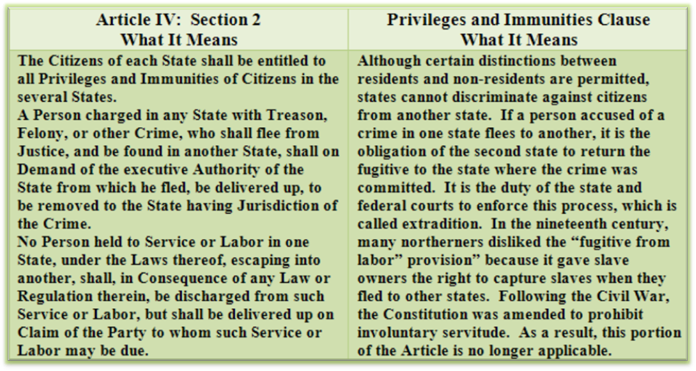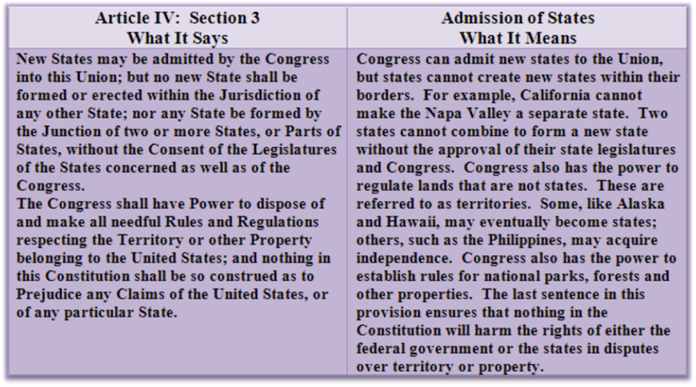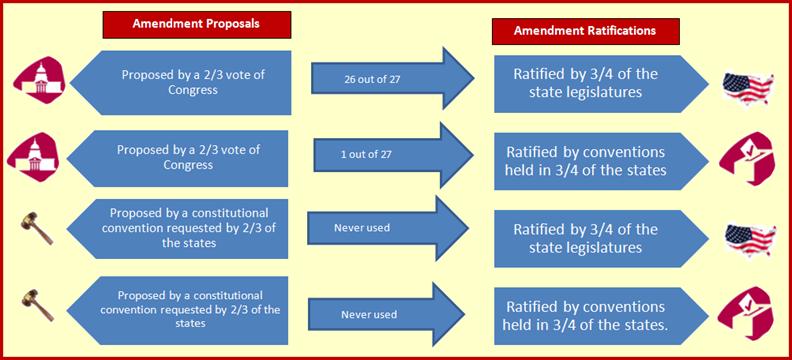PLANNING
FOR THE FUTURE: ARTICLES IV-VII

The Constitution Displayed at the National Archives
Unit Overview
The Founding Fathers understood the importance of
balancing power among the three branches of government, but they also
recognized that the United States would grow and change. For the new nation to achieve a sense of
stability, the role of state government needed to be defined and
clarified. A number of provisions in
Articles IV through VII of the United States Constitution were written with
these points in mind. At the same time,
the Constitution had to fulfill the promises set forth in its Preamble,
including the obligations “to form a more perfect union…to provide for the common
defense…and to insure domestic tranquility.”
Let’s see how all this was reflected in Articles IV though VII.

National Debt Clock
Article IV
Much of Article IV of the Constitution deals with
the ways in which states relate to one another and to the federal
government. Under the Articles of
Confederation, each state coined its own money, devised its own standards of
weights and established its own intrastate laws without considering a national
norm. If the country was truly going to
unite, the states had to recognize the authority of a central government while
maintaining a certain degree of autonomy. This division of power between the
state and federal governments, known as federalism, is still being defined
today. The four sections of Article IV
provide a basis for the relationship between the national and state
governments.




![]() Go to Questions 1-5.
Go to Questions 1-5.
Article V
The delegates at the Constitutional Convention
wanted the Constitution to have the flexibility to adapt to changing times and
circumstances. The elastic clause and
the process of judicial review have helped American government to adjust to
various times and circumstances. Article
V, also known as the amending article, discusses how changes or amendments can be added to make the
Constitution a true, living document.
Since amendments are proposed on the national level and ratified on the
state level, the process of adopting amendments also reflects the principle of
federalism. Thousands of amendments have
been suggested but only twenty-seven have actually been approved.
There are several ways to propose and ratify
amendments.
Ø 1. Congress may propose an amendment if it is
approved by 2/3 of its members. To
become active, the proposal must be ratified by the state legislatures in ¾ of
the states. This means that thirty-eight
state legislatures must approve or ratify the proposal. Twenty-six of the twenty-seven amendments
have been adopted by this method.
Ø 2. A proposal, approved by 2/3 of Congress, can
also become an amendment if it is ratified by conventions called within the
states for this purpose. The adoption of
amendments under this plan requires approval by ¾ of these state
conventions. Only Amendment XXI has been
ratified through this process.
Ø 3. Congress may also call a national convention
at the request of 2/3 of state legislatures to propose an amendment. Today, this means that thirty-four states
must be in agreement. The proposed
amendment must be ratified by ¾ of the state legislatures, if it is to become
part of the Constitution. Congress has
never called a convention of this type, and no amendments have been adopted
using this method.
Ø 4. When amendments are proposed by national
conventions called by Congress at the request of 2/3 of the state legislatures,
states may use ratifying conventions rather than their state legislatures to
approve amendments to the Constitution.
A suggested amendment is only added to the Constitution if ¾ of the
state conventions agree. Although this plan
was the basis for the ratification of the Constitution itself, no amendments
have been adopted using this process.

To learn more on Article V, click on the
links below:
Article V and the amendment process (article) | Khan Academy
Article V of the Constitution (video) | Khan Academy
The Constitution of the United States (article) | Khan Academy
The process seems complicated, but the Founding
Fathers did not want it to be easy to change the Constitution. At the time, they
realized that the unanimous vote of state legislatures stipulated by the
Articles of Confederation was impractical.
Although several Federalists and Anti-federalists held conflicting views
concerning the terms established in Article V, Thomas Jefferson believed it was
a significant achievement.

![]() Go to Questions 6-12.
Go to Questions 6-12.
Articles VI and VII
In
Article VI, the authors of the Constitution wanted to be sure the document
would be the deciding factor for U.S. law.
Section 1 accepts that all debts owed by the government before
ratification of the Constitution would be honored. Congress had borrowed money during the
American Revolution and had been unable to repay it under the Articles of
Confederation. This provision
established that the new country would be responsible for its debts.

Section
2 of Article VI is also known as the supremacy
clause. Even though the Constitution
is rooted in the principle of federalism, state laws and federal laws often
come into conflict. If a state
constitution or law contradicts the Constitution or a national treaty, it is
the Constitution that is the supreme authority.
State courts must also uphold the provisions of the Constitution. For example, Virginia’s state constitution
included a poll tax that voters were required to pay for participation in
presidential elections. In 1964, a
constitutional amendment prohibited the practice. This made Virginia’s voting requirement
unconstitutional. Section 3 also
emphasizes the final authority of the Constitution. It demands that all government officials take
an oath of office and swear to
uphold the Constitution of the United States.
Click on the link below to see and hear Barack Obama take the oath for
the presidency.
![]() Obama, Barack: Oath of Office and Inaugural Address (21:06)
Obama, Barack: Oath of Office and Inaugural Address (21:06)
The
final article, Article VII, explains the process that must be followed for
ratification. Because the unanimous vote
that was required by the Articles of Confederation had proved impractical, only
nine of the thirteen states had to agree to accept the Constitution. State conventions, whose members were
selected for this specific purpose, rather than state legislatures debated and
voted on this issue. The framers of the
Constitution believed that this method reflected the will of the people more
accurately and supported the concept that the real power in American government
came from the governed. To see Articles
VI and VII in their original text, click on the icon or PDF below.
![]() Article VI
Constitution
PDF
Article VI
Constitution
PDF
![]() Article VII
Constitution
PDF
Article VII
Constitution
PDF
![]() Go to Questions 13-16.
Go to Questions 13-16.
What’s Next?
Thanks to the articles discussed in this unit, the
United States Constitution has become a living document that continues to
provide a framework for American government.
However, it has always had its share of critics. When states were first asked to consider its
ratification, many citizens believed that the Constitution did not do enough to
protect individual rights and freedoms in the areas of religion and
speech. The new amendment process was
quickly tested and found to be an adequate method of change. The first ten amendments, known as the Bill
of Rights, are still subject to clarification and controversy. Before continuing to the next unit, review
the terms related to Articles IV through VII.
![]() Go to Questions 17-26.
Go to Questions 17-26.

Below are additional educational resources and activities for this unit.